Book of the Month: February 2025
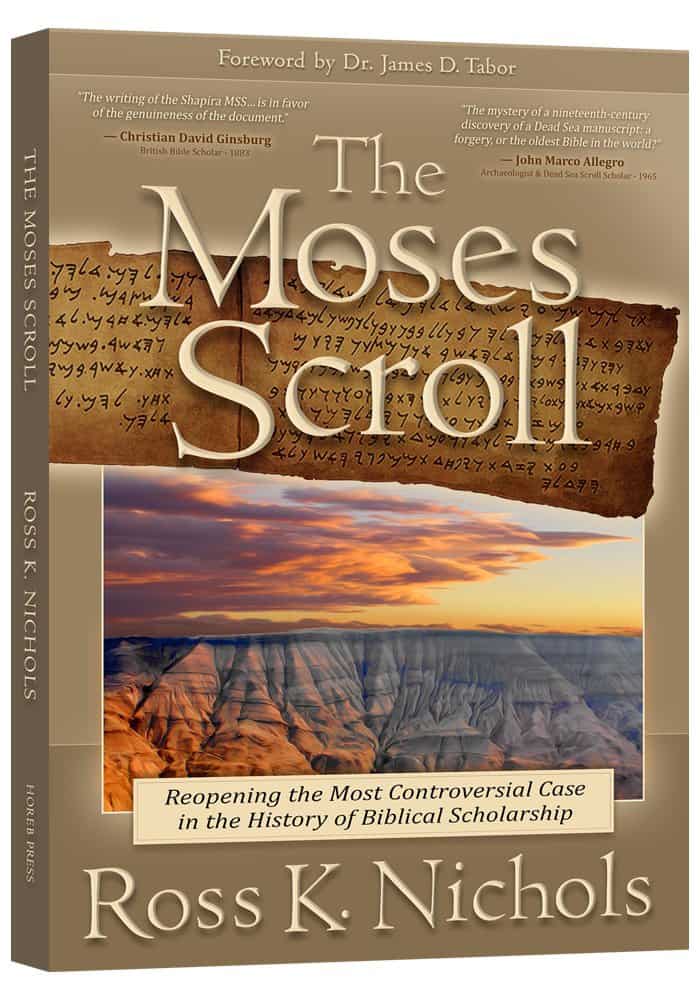 Ross K. Nichols: The Moses Scroll: Reopening the Most Controversial Case in the History of Biblical Scholarship (Horeb Press, St Francisville, LA, 2021). Hardcover, Kindle, Audio. If you like non-fiction mysteries and thrillers that in the end provide you with fascinating and well researched historical materials then this is the book for you. This is the most engaging story I have encountered in my entire career as a Biblical scholar. I was pleased to write the Forward. This little book should be in the library of anyone who likes to delve into the ancient past as it related to biblical texts–once thought to be a forgery in the 1880s, might well be the OLDEST Dead Sea Scroll ever discovered. You be the judge. I am 90% convinced it is an authentic ancient scroll, and not a clever 19th century forgery. It has disappeared but a team of researchers is hot on the trail to find its present whereabouts so it can be properly tested.
Ross K. Nichols: The Moses Scroll: Reopening the Most Controversial Case in the History of Biblical Scholarship (Horeb Press, St Francisville, LA, 2021). Hardcover, Kindle, Audio. If you like non-fiction mysteries and thrillers that in the end provide you with fascinating and well researched historical materials then this is the book for you. This is the most engaging story I have encountered in my entire career as a Biblical scholar. I was pleased to write the Forward. This little book should be in the library of anyone who likes to delve into the ancient past as it related to biblical texts–once thought to be a forgery in the 1880s, might well be the OLDEST Dead Sea Scroll ever discovered. You be the judge. I am 90% convinced it is an authentic ancient scroll, and not a clever 19th century forgery. It has disappeared but a team of researchers is hot on the trail to find its present whereabouts so it can be properly tested.
In 1878, a Jerusalem antiquities dealer named Moses Wilhelm Shapira acquired a curious biblical manuscript consisting of sixteen leather strips. The manuscript, written in ancient, Paleo-Hebrew, contained what appeared to be a form of the Bible’s Book of Deuteronomy but with significant variations. It was allegedly discovered by Bedouin tribesmen around 1865, east of the Dead Sea, in a remote cave, high above the Wadi Mujib (biblical Arnon). Shapira believed that his manuscript was both ancient and authentic. In 1883, he presented his scroll to the leading scholars of Europe. Newspapers around the world covered the unfolding story as scholars debated the genuineness of the leather strips. Ultimately the scroll was deemed a forgery and Shapira the forger. However, beginning in 1947, ancient scrolls discovered in the Qumran caves near the Dead Sea lead us to ask—were the critics wrong? The Moses Scroll documents the details of the entire saga based upon what we know today including a chronological telling of the fascinating story based upon 19th-century reports; an assessment of the genuineness of Shapira’s scroll; a new transcription of the manuscript as seen through the eyes of the 19th-century’s best Hebraists; and the author’s own translation of the original sixteen leather strips with a commentary and notes.
Highly Recommended Books
As an Amazon Associate I earn from qualifying purchases with no extra cost to buyers
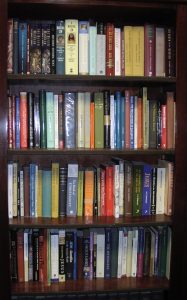
The books included below are from my personal library related to my academic field of study–and sometimes a bit beyond. They ALL come with my highest recommendation. They are included here in no particular order of importance but are organized into topical categories.
I have just begun this new feature on my blog and ask for patience as I gradually expand and organize it in a useful way those readers of mine who are looking for reliable sources dealing with the historical areas in which I work.
I will not include a book here unless I own it, have read it, and consider it among the best on the subject. I also plan on doing interviews on my Youtube channel (@jamestaborvideos) with selected authors in coordination with these listings.
MODERN MIDDLE EAST CONFLICTS
When it comes to the thousands of books and millions of articles on the so-called “Arab-Israeli” conflict–and I know I have read at least fifty of the main ones over the past forty years–I recommend two things: Maps and Documents.
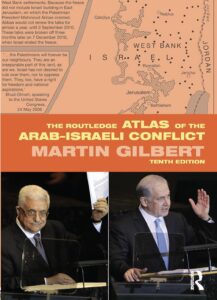
The best single course for understanding the minute details of what has gone on in the Holy Land since the 1800s I recommend first and foremost, Martin Gilbert, The Routledge ATLAS of the Arab-Israeli Conflict, 10th edition (London & New York: 2012). Paperback, Harcover, or Kindle. I have the paperback and the Kindle, as the latter allows you to do screen shots of the maps. It is a bit expensive, but worth its weight in gold, as the saying goes, and one could study the maps and data endlessly, in following current events or delving into past history. It is ESSENTIAL for any approach to the History of the Middle East. You have to know the maps!
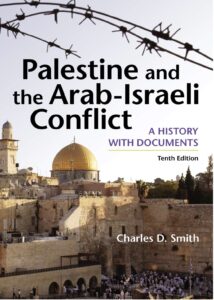 And then there are the Documents. I recommend Charles D. Smith, Palestine and the Arab-Israeli Conflict 10th edition(Boston & New York, 2021). Paperback, Hardcover, e-Textbook. Again, somewhat expensive, but well worth the price. Reading the documents with the maps will put you ahead of almost any single treatment or discussion of the “Middle East,” and it will also put you in a position to evaluate what you read and hear all the time via the media with some degree of knowledgable comprehension. As difficult as things are to sort out, with even the outright lies and biased presentations on all sides, looking at the actual documents puts one leagues ahead of any kind of futile “back and forth: dispute, as is so often the case.
And then there are the Documents. I recommend Charles D. Smith, Palestine and the Arab-Israeli Conflict 10th edition(Boston & New York, 2021). Paperback, Hardcover, e-Textbook. Again, somewhat expensive, but well worth the price. Reading the documents with the maps will put you ahead of almost any single treatment or discussion of the “Middle East,” and it will also put you in a position to evaluate what you read and hear all the time via the media with some degree of knowledgable comprehension. As difficult as things are to sort out, with even the outright lies and biased presentations on all sides, looking at the actual documents puts one leagues ahead of any kind of futile “back and forth: dispute, as is so often the case.
As an Amazon Associate I earn from qualifying purchases with no extra cost to buyers
TEXTS AND PRIMARY SOURCES
GENERAL BIBLICAL STUDIES
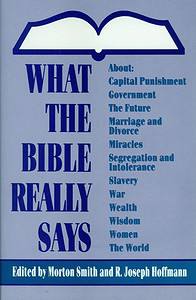 Back in 1989, as I was beginning my career as a young assistant professor, I was asked to contribute a chapter to this most interesting topical volume: Morton Smith and R. Joseph Hoffmann, eds. What the Bible Really Says About Death, Afterlife, and the Future (Prometheus, 1989).The topic list of chapters was quite broad, namely: Divorce, Slavery, Women, Capital Punishment, etc. My chapter ended up with the title, “What the Bible Really Says about Death, Afterlife, and the Future.” It was one of the most challenging tasks I had ever undertaken. To cover such a diverse top, essentially extending from the Ancient Near East and the Hebrew Bible, through the New Testament and the early Roman period, was surely more than a challenge. I believe this little book has held up well for over three decades. I consider it a collectors item. The acute and skillful editing of Professor Morton Smith alone makes the volume invaluable. I highly recommend!
Back in 1989, as I was beginning my career as a young assistant professor, I was asked to contribute a chapter to this most interesting topical volume: Morton Smith and R. Joseph Hoffmann, eds. What the Bible Really Says About Death, Afterlife, and the Future (Prometheus, 1989).The topic list of chapters was quite broad, namely: Divorce, Slavery, Women, Capital Punishment, etc. My chapter ended up with the title, “What the Bible Really Says about Death, Afterlife, and the Future.” It was one of the most challenging tasks I had ever undertaken. To cover such a diverse top, essentially extending from the Ancient Near East and the Hebrew Bible, through the New Testament and the early Roman period, was surely more than a challenge. I believe this little book has held up well for over three decades. I consider it a collectors item. The acute and skillful editing of Professor Morton Smith alone makes the volume invaluable. I highly recommend!
CHRISTIAN ORIGINS
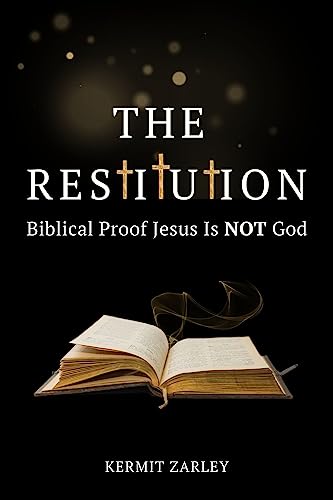 Some of my readers might know the name Kermit Zarley in connection with his career as a professional golfer, with notable finishes in dozens of PGA and Champions tournaments . However, Zarley is the author of a half dozen books on biblical topics. His magnum opus is this 540pp book, The Restitution: Biblical Proof Jesus is NOT God (Kermit Zarley: 2008) (Kindle), now out in a new edition. Although Zarley affirms the fundamentals of the Christian faith, he is convinced that the idea of the Trinity–which affirms Jesus of Nazareth is God, is nowhere affirmed or taught anywhere in the New Testament. For an evangelical Christian this is a most daring proposition, since by most orthodox creedal measures such a doctrinal affirmation is essential, not only for being a Christian but for salvation itself: Unless Jesus is eternally existent, fully God, it would be impossible for his death to save us. Following a brief Introduction and Zarley offers a most helpful overview of the History of Church Christology (Part One), and “Messianism in the Old Testament (Part Two). These are two areas that are essential as background for approaching the broader questions. For those not familiar with the raging controversies leading up to the 4th century Council of Nicea and its aftermath, this section will prove to be particularly useful.
Some of my readers might know the name Kermit Zarley in connection with his career as a professional golfer, with notable finishes in dozens of PGA and Champions tournaments . However, Zarley is the author of a half dozen books on biblical topics. His magnum opus is this 540pp book, The Restitution: Biblical Proof Jesus is NOT God (Kermit Zarley: 2008) (Kindle), now out in a new edition. Although Zarley affirms the fundamentals of the Christian faith, he is convinced that the idea of the Trinity–which affirms Jesus of Nazareth is God, is nowhere affirmed or taught anywhere in the New Testament. For an evangelical Christian this is a most daring proposition, since by most orthodox creedal measures such a doctrinal affirmation is essential, not only for being a Christian but for salvation itself: Unless Jesus is eternally existent, fully God, it would be impossible for his death to save us. Following a brief Introduction and Zarley offers a most helpful overview of the History of Church Christology (Part One), and “Messianism in the Old Testament (Part Two). These are two areas that are essential as background for approaching the broader questions. For those not familiar with the raging controversies leading up to the 4th century Council of Nicea and its aftermath, this section will prove to be particularly useful.
Zarley then devotes the next 350 pages (Part Three) to an incredibly detailed examination of every text in the New Testament (Synoptics, John, Paul, Hebrews, Peter, and the Apocalypse) that deals in any way with Christology–an understanding of who Jesus is affirmed to be vis-a-vis the One Creator God of the Hebrew Bible. To say his treatment is exhaustive is an understatement. Whether one agrees with his conclusions or not–he does not shy away in dealing with even the texts which are considered the bedrock of Trinitarian faith. The book contains an extensive bibliography, not only of works cites, but of every major academic book dealing with the subject generally of whether the New Testament anywhere affirms that Jesus is God.
Although my own approach to these materials is quite different from that of Zarley, and more along the lines of James G. D. Dunn, Christology in the Making or James F. McGrath, James F. McGrath, The Only True God: Early Christian Monotheism in Its Jewish Context, I recommend Zarley’s work to those readers who want to deeply dive into this question from a more evangelical perspective.
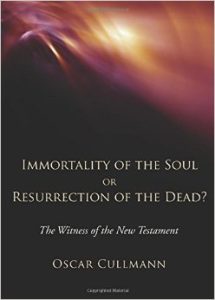 Oscar Cullmann’s famous Ingersoll Lecture of 1955 was titled: “Immortality of the Soul or Resurrection of the Dead?” in just that “either or” fashion. The original version published by Harvard University Press is long ago out of print but fortunately it has been reprinted over the years in various versions. I recommend the reprint edition by Wipf & Stock, Immortality of the Soul or Resurrection of the Dead?: The Witness of the New Testament (Wipf & Stock, 2000). If you have not read this little 60 page book, but are interested in the history of ideas in western antiquity, it is a must read. The reason think that this little book may well be one of the best known in my field–but also the most forgotten and neglected–is that its essential argument has been just about been completely ignored in popular Christian discourse today. My guess is Cullmann’s little book is likely unknown to most students of Christian origins younger than 50. His thesis is a simple one but with complex cosmic implications: That the idea of resurrection of the dead in the New Testament is in stark contract–even opposite of–the common Greek idea of the immortality of the soul. This is a book that more or less “overturns the world,” but its implications have not permeated either the church or the academy. I do find problems with Cullmann’s absolutely sharp dichotomy between “Athens and Jerusalem,” however, if one compares Plato’s Phaedo with Paul’s understanding of “resurrection of the dead,” both of Jesus and at the Parousia or End of the Age, I think his distinctions are worth noting and shift things considerably in trying to understand Paul’s message, at least, as it made its way out into the wider Greco-Roman Mediterranean world.
Oscar Cullmann’s famous Ingersoll Lecture of 1955 was titled: “Immortality of the Soul or Resurrection of the Dead?” in just that “either or” fashion. The original version published by Harvard University Press is long ago out of print but fortunately it has been reprinted over the years in various versions. I recommend the reprint edition by Wipf & Stock, Immortality of the Soul or Resurrection of the Dead?: The Witness of the New Testament (Wipf & Stock, 2000). If you have not read this little 60 page book, but are interested in the history of ideas in western antiquity, it is a must read. The reason think that this little book may well be one of the best known in my field–but also the most forgotten and neglected–is that its essential argument has been just about been completely ignored in popular Christian discourse today. My guess is Cullmann’s little book is likely unknown to most students of Christian origins younger than 50. His thesis is a simple one but with complex cosmic implications: That the idea of resurrection of the dead in the New Testament is in stark contract–even opposite of–the common Greek idea of the immortality of the soul. This is a book that more or less “overturns the world,” but its implications have not permeated either the church or the academy. I do find problems with Cullmann’s absolutely sharp dichotomy between “Athens and Jerusalem,” however, if one compares Plato’s Phaedo with Paul’s understanding of “resurrection of the dead,” both of Jesus and at the Parousia or End of the Age, I think his distinctions are worth noting and shift things considerably in trying to understand Paul’s message, at least, as it made its way out into the wider Greco-Roman Mediterranean world.
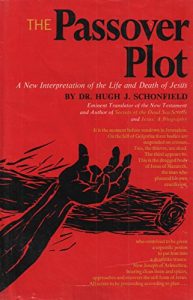 The late Hugh Schonfield was a brilliant scholar who came to international fame in 1965 with the publication of his controversial and best-selling book, The Passover Plot. I like millions of others read it avidly and followed the controversies closely. I remember traveling on a flight just after it came out and seeing half a dozen people reading their copies of The Passover Plot. I think it ended up selling over 2 million copies. I was in college at the time but in later years I corresponded with Dr. Schonfield, when I was in graduate school at the University of Chicago. We developed a cordial and meaningful relationship. I was never able to endorse the thesis of the book, though I still recommend it highly for the ways it puts the historical Jesus in his late 2nd Temple Jewish/Roman world. The book was considered sensational and dismissed by just about every mainstream scholar. i believe everyone interested in Christian Origins should read it anyway–just for its historic place in our culture as well as its considerable historical value. Here is a blog post I wrote about Schonfield and his book on its 40th anniversary, “Hugh Schonfield and the Passover Plot–A Retrospective.”
The late Hugh Schonfield was a brilliant scholar who came to international fame in 1965 with the publication of his controversial and best-selling book, The Passover Plot. I like millions of others read it avidly and followed the controversies closely. I remember traveling on a flight just after it came out and seeing half a dozen people reading their copies of The Passover Plot. I think it ended up selling over 2 million copies. I was in college at the time but in later years I corresponded with Dr. Schonfield, when I was in graduate school at the University of Chicago. We developed a cordial and meaningful relationship. I was never able to endorse the thesis of the book, though I still recommend it highly for the ways it puts the historical Jesus in his late 2nd Temple Jewish/Roman world. The book was considered sensational and dismissed by just about every mainstream scholar. i believe everyone interested in Christian Origins should read it anyway–just for its historic place in our culture as well as its considerable historical value. Here is a blog post I wrote about Schonfield and his book on its 40th anniversary, “Hugh Schonfield and the Passover Plot–A Retrospective.”
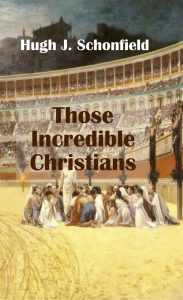 That is unfortunate because Schonfield was a brilliant scholar of Christian Origins and ancient Judaism and published many other very fine books that are little known to scholars–and to the public. One of the best, in my view, is Those Incredible Christians (Bantam, 1969) (Hardcover and Kindle). In fact, I would rate it as among the very best general books on Jesus and his movement down through the 1st century. The two appendices on the “The Christology of Paul” and the “The Christology of John,” alone are worth the price of the book. I highly recommend a careful reading. When people want to talk to me about what I believe about Jesus and early “Christianity,” I often tell them–read Those Incredible Christians first and then we can talk. Copies are available in various formats and it has been reissued.
That is unfortunate because Schonfield was a brilliant scholar of Christian Origins and ancient Judaism and published many other very fine books that are little known to scholars–and to the public. One of the best, in my view, is Those Incredible Christians (Bantam, 1969) (Hardcover and Kindle). In fact, I would rate it as among the very best general books on Jesus and his movement down through the 1st century. The two appendices on the “The Christology of Paul” and the “The Christology of John,” alone are worth the price of the book. I highly recommend a careful reading. When people want to talk to me about what I believe about Jesus and early “Christianity,” I often tell them–read Those Incredible Christians first and then we can talk. Copies are available in various formats and it has been reissued.
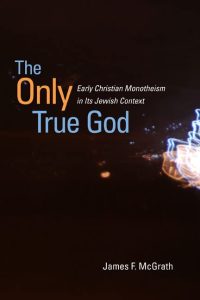 James F. McGrath, The Only True God: Early Christian Monotheism in Its Jewish Context (University of Illinois Press, 2000). (Kindle link). This little book of 156pp. is one of the most valuable I have read on the all important question of whether and to what extent Christians abandoned the idea of the “One God” of the Hebrew Bible in viewing Jesus as divine (“Son of God” “God in the flesh” or “Exalted Lord in heaven”)–however that was defined. McGrath dives deeply into all the main issues on this question, covering the New Testament writings (Gospels, Paul, Revelation), as well as the Jewish views of monotheism in the late 2nd Temple period. He concludes with the question of whether it was the views of Jesus that his followers held that let to the “parting of the ways” between early Christians and Jews–or whether there were other factors that proved more decisive in the break between these sister faiths. The book is well written, clear, and fully documented with academic source notes and a very complete bibliography. It is a marvelous read, one that everyone interested in how Christianity emerged from its Jewish origins during the first hundred years.
James F. McGrath, The Only True God: Early Christian Monotheism in Its Jewish Context (University of Illinois Press, 2000). (Kindle link). This little book of 156pp. is one of the most valuable I have read on the all important question of whether and to what extent Christians abandoned the idea of the “One God” of the Hebrew Bible in viewing Jesus as divine (“Son of God” “God in the flesh” or “Exalted Lord in heaven”)–however that was defined. McGrath dives deeply into all the main issues on this question, covering the New Testament writings (Gospels, Paul, Revelation), as well as the Jewish views of monotheism in the late 2nd Temple period. He concludes with the question of whether it was the views of Jesus that his followers held that let to the “parting of the ways” between early Christians and Jews–or whether there were other factors that proved more decisive in the break between these sister faiths. The book is well written, clear, and fully documented with academic source notes and a very complete bibliography. It is a marvelous read, one that everyone interested in how Christianity emerged from its Jewish origins during the first hundred years.
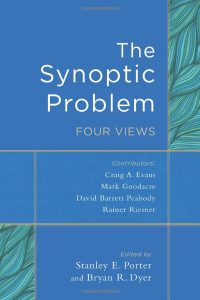 I highly recommend the marvelous little book edited by Stanley E. Porter and Bryan R. Dyer, The Synoptic Problem: Four Views (Baker Academic, 2016). (Kindle link). Arguments about the “Synoptic Problem” can easily become both confusing and polarizing, but this book is ideal. It includes contributions from Craig Evans, Mark Goodacre, David Peabody, and Rainer Riesner–each holding different views, but in dialogue and exchange with one another in a non-adversarial way. This is absolutely a must have book for anyone wanting to understand the basics of the academic study of our first three N.T. gospels. It allows one to cut through the confusion of various positions and why this or that person might hold one or the other.One of the fundamental challenges of any serious study of what scholars refer to as the “historical Jesus,” is to sort out the relationship between our three “Synoptic” gospels, which appear in the New Testament as Matthew, Mark, and Luke. They have a clear literary relationship–but the question of “priority” is fundamental. Did Matthew write first and then Luke and Mark compiled their accounts using Matthew as his source? That was the dominant view of the church until modern times, based on fragments we have of a 2nd century writer named Papias, but follow by Origen, Augustus and many others. This idea of “Matthew priority” is particularly associated with Johann Griesbach (1776).
I highly recommend the marvelous little book edited by Stanley E. Porter and Bryan R. Dyer, The Synoptic Problem: Four Views (Baker Academic, 2016). (Kindle link). Arguments about the “Synoptic Problem” can easily become both confusing and polarizing, but this book is ideal. It includes contributions from Craig Evans, Mark Goodacre, David Peabody, and Rainer Riesner–each holding different views, but in dialogue and exchange with one another in a non-adversarial way. This is absolutely a must have book for anyone wanting to understand the basics of the academic study of our first three N.T. gospels. It allows one to cut through the confusion of various positions and why this or that person might hold one or the other.One of the fundamental challenges of any serious study of what scholars refer to as the “historical Jesus,” is to sort out the relationship between our three “Synoptic” gospels, which appear in the New Testament as Matthew, Mark, and Luke. They have a clear literary relationship–but the question of “priority” is fundamental. Did Matthew write first and then Luke and Mark compiled their accounts using Matthew as his source? That was the dominant view of the church until modern times, based on fragments we have of a 2nd century writer named Papias, but follow by Origen, Augustus and many others. This idea of “Matthew priority” is particularly associated with Johann Griesbach (1776).
However, beginning in the early 20th century the idea of Markan priority began to really take hold among most scholars. This view is especially associated with B. H. Streeter (1924), though other 19th century scholars had proposed the idea as well. The argument is that Mark was used as the core narrative source by both Matthew and Luke, who edit it quite differently, and that both had another common source–the material common between them not from Mark, often called Q (Quelle in German, meaning “source.”), plus each author used independent materials (M and L). This is sometimes called the Two Source Hypothesis–or by some the Four Source Hypothesis, as in the chart above. This is my working hypothesis and you can watch a slide-illustrated presentation of my own views here: “Mark Is our Earliest Jesus Story–How We Know and Why it Matters!”
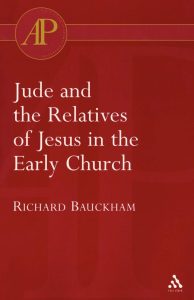 Richard Bauckham, Jude and the Relatives of Jesus in the Early Church (T&T Clark, 2000). I love the careful scholarship of Richard Bauckham and highly recommend this incredibly valuable volume. Too often mainstream New Testament scholarship has neglected not only so-called “Jewish Christianity,” but even more so, the “family of Jesus.” We have two N.T. letters attributed to James and Jude and our rather abundant sources on the so-called Desposynoi–as the relatives of Jesus are called in our early sources. Few have taken note of their history beyond the death of James in 62 CE, and the 70 CE destruction of Jerusalem by the Romans, but our sources indicate that the emperor Vespasian was acutely interested in this royal family and its potential threat to a revival of Messianic ideas, and Hadrian even arrested two grandsons of Judas, the brother of Jesus and had them questioned. The dogmas of the “virgin birth” and “perpetual virginity” of Jesus’ mother Mary, have contributed to this dearth of familiarity. Bauckham has provided the most solid academic study of which aware. His careful analytical methods, clear writing, and solidly detailed documentation make this volume a must have for anyone interested in Christian Origins. I have read and re-read this volume over the years and continue to learn from it. Don’t let the price put you off–it is well worth that and more, running 459 pages of invaluable resource materials.
Richard Bauckham, Jude and the Relatives of Jesus in the Early Church (T&T Clark, 2000). I love the careful scholarship of Richard Bauckham and highly recommend this incredibly valuable volume. Too often mainstream New Testament scholarship has neglected not only so-called “Jewish Christianity,” but even more so, the “family of Jesus.” We have two N.T. letters attributed to James and Jude and our rather abundant sources on the so-called Desposynoi–as the relatives of Jesus are called in our early sources. Few have taken note of their history beyond the death of James in 62 CE, and the 70 CE destruction of Jerusalem by the Romans, but our sources indicate that the emperor Vespasian was acutely interested in this royal family and its potential threat to a revival of Messianic ideas, and Hadrian even arrested two grandsons of Judas, the brother of Jesus and had them questioned. The dogmas of the “virgin birth” and “perpetual virginity” of Jesus’ mother Mary, have contributed to this dearth of familiarity. Bauckham has provided the most solid academic study of which aware. His careful analytical methods, clear writing, and solidly detailed documentation make this volume a must have for anyone interested in Christian Origins. I have read and re-read this volume over the years and continue to learn from it. Don’t let the price put you off–it is well worth that and more, running 459 pages of invaluable resource materials.
ANCIENT MEDITERRANEAN RELIGIONS AND CULTURE
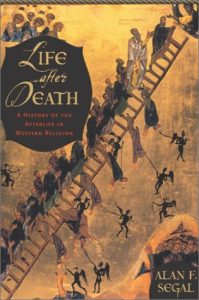 Alan Segal, Life After Death: A History of Afterlife in Western Religion (Doubleday, 2004). Alan Segal was a scholar of late Antiquity with a host of influential landmark books, including Rebecca’s Children and Two Powers in Heaven–both laying new ground in understanding the intersections between Jews and Christians. In this masterful exploration of how Western civilizations have defined the afterlife, Segal weaves together biblical and literary scholarship, sociology, history, and philosophy. Segal examines the complex maps of the afterlife found in Western religious texts and reveals not only what various cultures believed but how their notions reflected their societies’ realities and ideals, and why those beliefs changed over time. He maintains that the afterlife is the mirror in which a society arranges its concept of the self. The composition process for Judaism, Christianity, and Islam begins in grief and ends in the victory of the self over death.
Alan Segal, Life After Death: A History of Afterlife in Western Religion (Doubleday, 2004). Alan Segal was a scholar of late Antiquity with a host of influential landmark books, including Rebecca’s Children and Two Powers in Heaven–both laying new ground in understanding the intersections between Jews and Christians. In this masterful exploration of how Western civilizations have defined the afterlife, Segal weaves together biblical and literary scholarship, sociology, history, and philosophy. Segal examines the complex maps of the afterlife found in Western religious texts and reveals not only what various cultures believed but how their notions reflected their societies’ realities and ideals, and why those beliefs changed over time. He maintains that the afterlife is the mirror in which a society arranges its concept of the self. The composition process for Judaism, Christianity, and Islam begins in grief and ends in the victory of the self over death.
Arguing that in every religious tradition the afterlife represents the ultimate reward for the good, Segal combines historical and anthropological data with insights gleaned from religious and philosophical writings to explain the following mysteries: why the Egyptians insisted on an afterlife in heaven, while the body was embalmed in a tomb on earth; why the Babylonians viewed the dead as living in underground prisons; why the Hebrews remained silent about life after death during the period of the First Temple, yet embraced itin the Second Temple period (534 B.C.E. –70 C.E.); and why Christianity placed the afterlife in the center of its belief system. He discusses the inner dialogues and arguments within Judaism and Christianity, showing the underlying dynamic behind them, as well as the ideas that mark the differences between the two religions. In a thoughtful examination of the influence of biblical views of heaven and martyrdom on Islamic beliefs, he offers a fascinating perspective on the current troubling rise of Islamic fundamentalism.
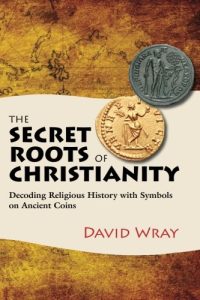 I highly recommend to all of my readers, and followers, David Wray’s 756 page book, The Secret Roots of Christianity (2012), dealing with astrology, magic, astral immortality and Greco-Roman art of the period, including astral symbols on coins.
I highly recommend to all of my readers, and followers, David Wray’s 756 page book, The Secret Roots of Christianity (2012), dealing with astrology, magic, astral immortality and Greco-Roman art of the period, including astral symbols on coins.
ARCHAEOLOGY OF ANCIENT JUDAISM, EARLY CHRISTIANITY, THE ROMAN WORLD
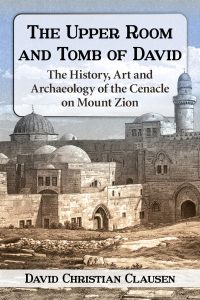 David Clausen, The Upper Room and Tomb of David: The History, Art and Archaeology of the Cenacle on Mount Zion (McFarland, 2016). This fascinating Medieval structure, visited by millions of Christian a year as the “Room of the Last Supper,” whereas the lower floor is revered by Jews as the “Tomb of David.” However, the foundations of this structure date back to the Byzantine period, and according to some the first century CE. In this groundbreaking study of all our major textual and archaeological evidence, my former M.A. student, David Clausen, who worked with Shimon Gibson and me on this project, has published an engaging, readable, study.
David Clausen, The Upper Room and Tomb of David: The History, Art and Archaeology of the Cenacle on Mount Zion (McFarland, 2016). This fascinating Medieval structure, visited by millions of Christian a year as the “Room of the Last Supper,” whereas the lower floor is revered by Jews as the “Tomb of David.” However, the foundations of this structure date back to the Byzantine period, and according to some the first century CE. In this groundbreaking study of all our major textual and archaeological evidence, my former M.A. student, David Clausen, who worked with Shimon Gibson and me on this project, has published an engaging, readable, study.
Claimed by Jews, Christians and Muslims, the sacred structure continues to evoke passionate controversy. Does it date back to the time of Christ? Was the Last Supper celebrated there? Is this the place where the Holy Spirit descended on the apostles on the first Pentecost following Easter Sunday? Did King David’s remains ever lie there?
These and many other questions are explored in this first-ever study, offering a readable, fully researched narrative account of the Cenacle’s history, archaeology and imagery. Artistic, architectural and photographic illustrations document the Cenacle and its surroundings over the past 1,500 years.
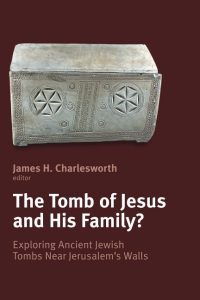 James H. Charlesworth, editor, The Tomb of Jesus and His Family? Exploring Ancient Jewish Tombs Near Jerusalem (Eerdmans, 2013). In 1980 archaeologists unearthed a tomb near Jerusalem that contained a family’s ossuaries inscribed with some familiar New Testament names, including Mary, Joseph, and Jesus. In 2007 the Discovery Channel produced and broadcast a documentary called The Lost Tomb of Jesus, raising interest — and controversy — among the public and specialists alike. Could this actually be the tomb of Jesus and his family?
James H. Charlesworth, editor, The Tomb of Jesus and His Family? Exploring Ancient Jewish Tombs Near Jerusalem (Eerdmans, 2013). In 1980 archaeologists unearthed a tomb near Jerusalem that contained a family’s ossuaries inscribed with some familiar New Testament names, including Mary, Joseph, and Jesus. In 2007 the Discovery Channel produced and broadcast a documentary called The Lost Tomb of Jesus, raising interest — and controversy — among the public and specialists alike. Could this actually be the tomb of Jesus and his family?
In January of 2008 a group of internationally renowned scholars from a broad range of disciplines met in Jerusalem to discuss that very question. Covering the archaeological facts about the discovery, Jewish burial customs during the late Second Temple period, first-century inscriptions, the Talpiot tomb, the James ossuary, the Holy Sepulcher, and more, this volume presents their expert perspectives on a much-publicized topic.
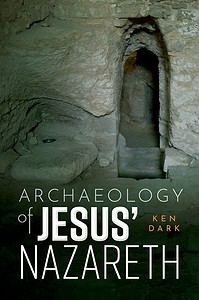 Ken Dark, Archaeology of Jesus’ Nazareth (Oxford, 2023) (Kindle link), is a marvelous little “must have” volume for anyone interested in the a readable summary of the evidence. The archaeology of ancient 1st century CE Nazareth has been controversial over the years, with some even claiming there was no such village of that name in the time of Jesus, given it is only mentioned in the New Testament (Mark 1:9; Luke 1:26; 4:6, John 1:45, et al.) Ken Dark has been at the forefront of the debate, focusing on the subterranean levels under the Sisters of Nazareth convent site, which I have visited, as well as other remains around the Church of the Annunciation complex. Dark has published previous academic books which I also own, including The Sisters of Nazareth Convent: A Roman-period, Byzantine, and Crusader site in central Nazareth (The Palestine Exploration Fund Annual) (Routledge, 2022) (Hardcover and Kindle links), but this 2023 Oxford volume serves as a comprehensive summary of the whole. I highly recommend this book for every Christian Origins library.
Ken Dark, Archaeology of Jesus’ Nazareth (Oxford, 2023) (Kindle link), is a marvelous little “must have” volume for anyone interested in the a readable summary of the evidence. The archaeology of ancient 1st century CE Nazareth has been controversial over the years, with some even claiming there was no such village of that name in the time of Jesus, given it is only mentioned in the New Testament (Mark 1:9; Luke 1:26; 4:6, John 1:45, et al.) Ken Dark has been at the forefront of the debate, focusing on the subterranean levels under the Sisters of Nazareth convent site, which I have visited, as well as other remains around the Church of the Annunciation complex. Dark has published previous academic books which I also own, including The Sisters of Nazareth Convent: A Roman-period, Byzantine, and Crusader site in central Nazareth (The Palestine Exploration Fund Annual) (Routledge, 2022) (Hardcover and Kindle links), but this 2023 Oxford volume serves as a comprehensive summary of the whole. I highly recommend this book for every Christian Origins library.
 This lovely book by Richard A. Batey, Jesus and the Forgotten City: New Light on Sepphoris and the Urban World of Jesus (Grand Rapids: Baker Book House, 1991), is a delightful introduction to the archaeology at the site of Sepphoris, the urban capital of the Galilee in the time of Jesus. Many of us think that Jesus’ reference to a “city set on a hill,” could well be to Sepphoris. Herod Antipas rebuilt in glorious style after the revolt of 4 BCE following the death of his father, Herod the Great. The Jewish Historian Josephus calls it the “ornament of the Galilee.” The tiny hamlet of Nazareth, part of the larger village of Japhia, was just 3.5 miles to the SW, and could well be seen as a “suburb” of the Greco-Roman capital. Batey has published academic articles on the subject of what light this proximity might have meant to Jesus and his family, working as tektons-or builders, likely working in stone–in exposing him to this urban environment. This is very much a “coffee-table” book, with beautiful photos and color illustrations. Batey took part in the excavations at Sepphoris in the 1980s.
This lovely book by Richard A. Batey, Jesus and the Forgotten City: New Light on Sepphoris and the Urban World of Jesus (Grand Rapids: Baker Book House, 1991), is a delightful introduction to the archaeology at the site of Sepphoris, the urban capital of the Galilee in the time of Jesus. Many of us think that Jesus’ reference to a “city set on a hill,” could well be to Sepphoris. Herod Antipas rebuilt in glorious style after the revolt of 4 BCE following the death of his father, Herod the Great. The Jewish Historian Josephus calls it the “ornament of the Galilee.” The tiny hamlet of Nazareth, part of the larger village of Japhia, was just 3.5 miles to the SW, and could well be seen as a “suburb” of the Greco-Roman capital. Batey has published academic articles on the subject of what light this proximity might have meant to Jesus and his family, working as tektons-or builders, likely working in stone–in exposing him to this urban environment. This is very much a “coffee-table” book, with beautiful photos and color illustrations. Batey took part in the excavations at Sepphoris in the 1980s.
THE DEAD SEA SCROLLS
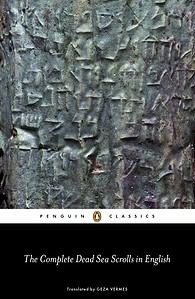 Geza Vermes, The Complete Dead Sea Scrolls in English 7th Edition (Penguin, 2012). I bought my first copy of this fine little paperback volume in 1973 in graduate school at the university of Chicago–it was the 1st edition and I still have it–and I have bought every edition since then. It has grown now from 258pp to 698pp! There are several other English translations that are useful–especially Wise/Abegg/Cook and Martínez, but for students and general readers I find this edition the best. This is the one I use in all my courses. It is relatively complete on all the main sectarian texts and contains a most helpful index, listing of all the Caves and the scrolls found in each, and a very full Introduction. (Kindle edition link)
Geza Vermes, The Complete Dead Sea Scrolls in English 7th Edition (Penguin, 2012). I bought my first copy of this fine little paperback volume in 1973 in graduate school at the university of Chicago–it was the 1st edition and I still have it–and I have bought every edition since then. It has grown now from 258pp to 698pp! There are several other English translations that are useful–especially Wise/Abegg/Cook and Martínez, but for students and general readers I find this edition the best. This is the one I use in all my courses. It is relatively complete on all the main sectarian texts and contains a most helpful index, listing of all the Caves and the scrolls found in each, and a very full Introduction. (Kindle edition link)
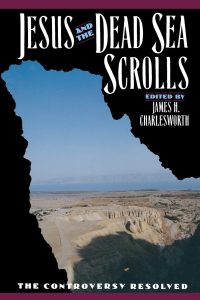 This most useful collection of essays in the Yale Anchor Bible Reference Library, edited by James H. Charlesworth, Jesus and the Dead Sea Scrolls: The Controversy Resolved (New York: Doubleday, 1992) 370 pp. [paper and hardcover] has endured the test of time over the past three decades. It contains twelve essays written by a selective “Who’s Who” of classic Dead Sea Scrolls research, along with Bibliography, and selected indices. The Forward (“A Critical Consensus”) as well as Chapter One, “The Dead Sea Scrolls and the Historical Jesus,” both written by Charlesworth, is worth the price of the book–both for what it says–thirty years ago–and what it represents. Charlesworth also contributes a chapter on Jesus and the Righteous Teacher. The other ten contributors represent both topically and methodologically a nice balance of DSS scholarship at the time: Otto Betz, Howard C. Kee, Paolo Sacchi, David Flusser, Rainer Riesner, Craig A. Evans, James D. G. Dunn, Joe Zias, Morton Smith, and Alan Segal. In my view each of these contributions continues to be valuable. I particularly note Morton Smith’s provocative essay, “Two Ascended to Heaven–Jesus and the Author of 4Q491,” as way ahead of its time. And Alan Segal’s contribution, “The Risen Christ and the Angelic Mediator Figures in the Light of Qumran,” has also become classic. This little volume goes particularly well with my on-line course by the same title: “Jesus and the Dead Sea Scrolls,” to be released in September 2023.
This most useful collection of essays in the Yale Anchor Bible Reference Library, edited by James H. Charlesworth, Jesus and the Dead Sea Scrolls: The Controversy Resolved (New York: Doubleday, 1992) 370 pp. [paper and hardcover] has endured the test of time over the past three decades. It contains twelve essays written by a selective “Who’s Who” of classic Dead Sea Scrolls research, along with Bibliography, and selected indices. The Forward (“A Critical Consensus”) as well as Chapter One, “The Dead Sea Scrolls and the Historical Jesus,” both written by Charlesworth, is worth the price of the book–both for what it says–thirty years ago–and what it represents. Charlesworth also contributes a chapter on Jesus and the Righteous Teacher. The other ten contributors represent both topically and methodologically a nice balance of DSS scholarship at the time: Otto Betz, Howard C. Kee, Paolo Sacchi, David Flusser, Rainer Riesner, Craig A. Evans, James D. G. Dunn, Joe Zias, Morton Smith, and Alan Segal. In my view each of these contributions continues to be valuable. I particularly note Morton Smith’s provocative essay, “Two Ascended to Heaven–Jesus and the Author of 4Q491,” as way ahead of its time. And Alan Segal’s contribution, “The Risen Christ and the Angelic Mediator Figures in the Light of Qumran,” has also become classic. This little volume goes particularly well with my on-line course by the same title: “Jesus and the Dead Sea Scrolls,” to be released in September 2023.
APOCALYPTICISM THROUGH THE AGES
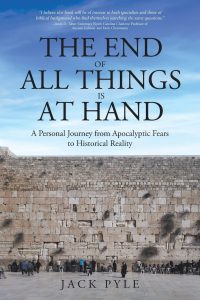 Jack Pyle, The End of All Things is at Hand: A Personal Journey from Apocalyptic Fears to Historical Reality (2022) Paperback (Kindle). The author reflects on his time in the Herbert W. Armstrong/Worldwide Church of God movement that flourished in the late 20th century as one of the most widespread apocalyptic movements in recent times. Pyle’s personal story is utterly fascinating, but through his interactions with various academic scholars of the New Testament and Christian Origins, one learns a great deal along the way about responsible historical approaches to the Bible and its diverse history. (Kindle Edition link)
Jack Pyle, The End of All Things is at Hand: A Personal Journey from Apocalyptic Fears to Historical Reality (2022) Paperback (Kindle). The author reflects on his time in the Herbert W. Armstrong/Worldwide Church of God movement that flourished in the late 20th century as one of the most widespread apocalyptic movements in recent times. Pyle’s personal story is utterly fascinating, but through his interactions with various academic scholars of the New Testament and Christian Origins, one learns a great deal along the way about responsible historical approaches to the Bible and its diverse history. (Kindle Edition link)
